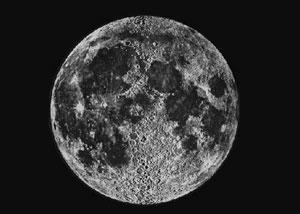Source: NASA
10-19-2007 11:02

The moon's surface shows striking contrasts of light and dark. The light areas are rugged highlands. The dark zones were partly flooded by lava when volcanoes erupted billions of years ago. The lava froze to form smooth rock. Image credit: Lunar and Planetary Institute.(NASA photo)
Moon is Earth's only natural satellite and the only astronomical body other than Earth ever visited by human beings. The moon is the brightest object in the night sky but gives off no light of its own. Instead, it reflects light from the sun. Like Earth and the rest of the solar system, the moon is about 4.6 billion years old.
The moon is much smaller than Earth. The moon's average radius (distance from its center to its surface) is 1,079.6 miles (1,737.4 kilometers), about 27 percent of the radius of Earth.
The moon is also much less massive than Earth. The moon has a mass (amount of matter) of 8.10 x 1019 tons (7.35 x 1019 metric tons). Its mass in metric tons would be written out as 735 followed by 17 zeroes. Earth is about 81 times that massive. The moon's density (mass divided by volume) is about 3.34 grams per cubic centimeter, roughly 60 percent of Earth's density.
Because the moon has less mass than Earth, the force due to gravity at the lunar surface is only about 1/6 of that on Earth. Thus, a person standing on the moon would feel as if his or her weight had decreased by 5/6. And if that person dropped a rock, the rock would fall to the surface much more slowly than the same rock would fall to Earth.
Despite the moon's relatively weak gravitational force, the moon is close enough to Earth to produce tides in Earth's waters. The average distance from the center of Earth to the center of the moon is 238,897 miles (384,467 kilometers). That distance is growing -- but extremely slowly. The moon is moving away from Earth at a speed of about 1 1/2 inches (3.8 centimeters) per year.
